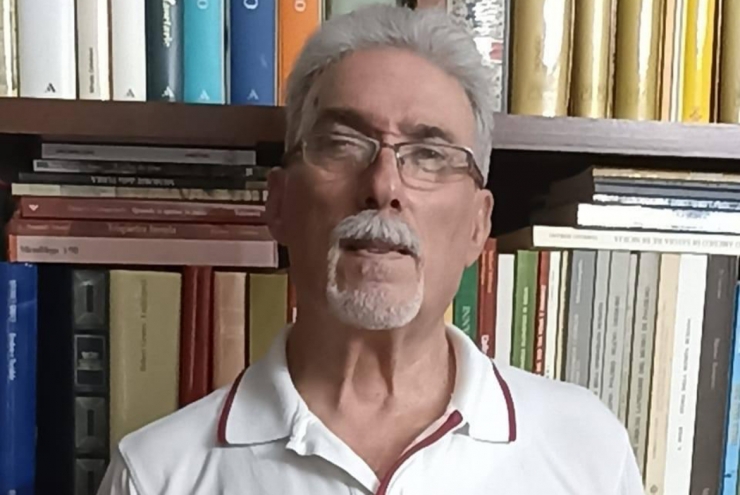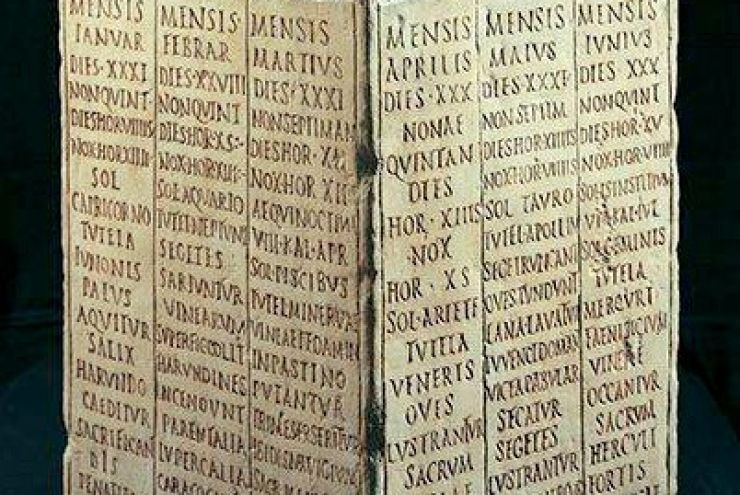 At the dawn of Neoplatonism: Chaldean Oracles.
At the dawn of Neoplatonism: Chaldean Oracles.
During the reign of Marcus Aurelius, Julian the Theurgist, son of Julian the Chaldean, received a series of divine messages that were later referred to as the Chaldean Oracles (χαλδαικὰ λόγια) for their Mesopotamian style and that became soon an essential component to the nascent Neoplatonism. These texts, written in Greek hexameters, exposed poetically a doctrine of profound wisdom, by describing a complex cosmological structure. Unfortunately, part of the work has gone lost during the centuries, but we have a series of fragments whispering an exciting page of mystery and spirituality.
The flickering of the oil lamp flame was casting a shadowy dance on the candy linen cloth on the “bomos”, the altar where various objects for theurgic practice were placed with a meticulous order, together with the rich offerings to the goddess Hecate. Julian, stood barefoot in front of the “bomos”. He was dressed in a long white coat, and immersed in a dense cloud of incense, while he was raising his arms to the sky, repeating rhythmically ancient formulas in arcane languages. His soul had left the body, forgetting of the senses that complained of the cold floor under bare feet, as well as the hunger for the purifying fast, or the burning eyes for the acre smoke of the offerings. He had learned the art of astral traveling by exercising his “ochema”, his psychic vehicle, and was ready to accept the divine light and to hear eternal words. Detached from the corporal prison, wandering toward an indefinite point of consciousness, suddenly his thoughts stopped, perhaps in the imperceptible break between two formulas of the ritual, or in a moment of flame immobility, at a time when there was no tension or attempt to understand anything: Julian transcended himself by caressing the abyss with his intuition, with the Flower of Intellect, and he instantly gained infinite knowledge.
After many hours of intense theurgic practice, he eventually came back exhausted to the reality, to the dark material basement where he used to celebrate his rituals. He felt cold at his feet that were freezing, and he felt hungry and even thirsty, wrinkling his eyes, trying to recover his blurred sight. Then he stretched the backbones to fight an incipient backache for the long-held posture. After storing the sacred objects, rearranging the bomos, relocating his dress to the closet, preparing a glass of water, wine, and honey, he went to the desk to write down everything he learned during his psychic journey, just before the sun could erase his memory:
“There is something you must grasp with the flower of intuition, for if you focus your intuition toward it, and conceive it as if you expect to intuit something determined, you will not catch it. It is like the power of a radiant force, which dazzles with intuitive spikes. You needn’s grasp it vehemently, but with the subtle flame of a subtle intuition that can measure everything, but not it directly; and you mustn’t intuit it with intensity, but you should stretch the pure look of your soul towards it, trying to imagine it, like a void, because it dwells outside the intuition.”
During Noumenia nights, in the deep darkness of the new moon, when the distance between the material world and the higher worlds fades, when the mind is more receptive to psychic impressions, he goes back to work on the bomos, to probe those ineffable truths and to hear the voice of the goddess Hecate. During the draining theurgical practice, he discovered that above all reality, there is a single principle out of time, the Transcendent Fire, the Sovereign, but also the Father, or even the Father’s Mind. This is essentially unknowable, indeed, it is called “the End of Knowledge“, “the Silence“. Yet, despite the invaluable distance, that Being does not inspire fear, but radiates persuasion and trust, such as the Good of Plato. The Being-Monad is not just an unknowable point. In fact, since it contains everything in itself, it also contains the potential of being everything. The Father expands beyond the abyss of ignorance because of his total possibility, or power, of intellectual revelation. This possibility of knowledge is what is termed “the Intelligible“. Here everything is in power, hidden in the senses. This power is the Dyad, the multiple feminine principle, the Bride of the Father’s Mind. The Dyad is therefore with Him. But this power is not manifested yet. It is not the universe yet. The Dyad is the detonator of the sequence, but it is not the very sequence of emanation.
According to the oracles, the first step occurs after the Power: “The Power is in Him, but the Mind is from Him“. In fact, the Power is the Intelligible, which does not have an intellectual motion because it already contains everything. However, as it can be thought of, it starts the cognitive chain. The universe and the perceptible world are generated by the demiurgic action of the energy of the Mind that at this level, acting as the Architect of Matter, is called the Mind of Mind, or the Mind of the Daughter of the Mind or more simply the Son. The Mind of Mind then proceeds from Father’s Mind through Power. The described entities constitute the trinity of Giuliano. Proclus, a few centuries later, identifies the Father with the ousía or the substance (hyparxis), the Mother with Life (Zoē), or with the Power (dynamis), and the Son with the operation or the actualization (energeia). The Monad, the unitary principle, contains in itself the power of multiplicity as Dyad and holds unity as a Triad. While two is the number of differences, the number three represents the first synthesis of unity and difference. Father’s Mind is linked to Plato’s design because the thoughts of the Father’s Mind coincide with Platonic ideas.
The power in the triad is the source of emanation and causes each term to originate its own triad so that a multidimensional, crystalline cosmic structure is generated. So there are three triads, respectively tied to the Father, to the Power, and to the Father’s Intellect. The Father’s Intellect is self-generating in his knowledge of himself. Likewise, he lives by living and exists by existing, distinct from the Father, even though for his perfection there is no insuperable limit to the Father, but he is reflecting Father’s structure with a trinity. This is called the Second Intellect and has the following functions: the generating power that organizes and controls the multiplicity present in the divinities called synokhēis (συνοχή, control), the function of identity with the Father through the divinities called iynges (ἴυγγες), the intellectual function of initiators or teletarchai (τελετάρχαι), who direct themselves to ideas and support the creating agents, by making the mind manifest in the universe.
The Paternal Intellect, facing the cosmos, is manifested as the triad of cosmic guides. The cosmic guide called “Once Beyond” reflects in its own intellectual trinity the unity of the Paternal Intellect as contemplation. The second term of the trinity of cosmic guides is Hecate, the Cosmic Soul, who reflects the operating intellect, his mind, his creative will, and the execution of his design. In Hecate’s maternal breast there lies the “Twice Beyond“, which generates what is contemplated by the “Once Beyond”. The cosmic guides are the sources of the universe and are found in the super-mundane or hyper-cosmic world. Below them, there is the boundary of the universe, divided too in ternary form. The power that keeps the cosmos united, while preventing its disintegration, proceeds from the synokheis through the iynges. The teletarchais bring the souls to the far end, to the breast of Hecate, the Cosmic Soul. The souls can come to Hecate if in their active part there are all the three components of faith, truth, and love. The soul’s functions can thus be in balance with the original source of being, of living (power), and knowing (intellect).
The souls, when they travel to the earth for the incarnation, go through the heavens and cover themselves with thin layers that constitute a wrapper called “the vehicle” (ochema). This vehicle is fully formed before the soul meets the body. In the polytheism of the first centuries, the existence of the vehicle was taken for granted. Actually, the vehicle was the basis of many important theurgic exercises: those who wanted to learn to travel out of their own body had to master the art of the astral journey on their psychic vehicle. This theurgic practice is used still today.
According to the Chaldean Oracles, the theurgist receives help from the goddess Hecate, the central figure of the whole system, who was later considered the goddess of magic and witchcraft for centuries. In fact, the daughter of Jupiter and Demeter is much more than this. Hecate is the personification of the World Soul that envelops everything and that nourishes the universe with the precious life. She is the intermediary between the Silence, the totally transcendent God, who dwells in the hyper-cosmic region beyond the world, and the universe itself.
Hecate, the Great Mother, is virgin and fruitful. Her head lies in the “once beyond”, where she contains all the archetypal truth, all the ideas or forms proceeding from the paternal intellect as the fruit of self-contemplation. But her hands lie in the “twice beyond”, where the agent and demiurgic intellect are active as vitalized by the Goddess. From here it is clear that Hecate is the goddess of life, the source of cosmic and hyper-cosmic life.
The message of the Chaldean Oracles is powerful and universal. Even today it is disconcerting to see how the Dyad-deity has manifested herself in different places in the world. Hecate, the goddess who propagates life from the One to the universe, the guide that raises the theurgist along a magical path, has been revealed in India as Śakti, the personified Divine Energy, who constantly vivifies the whole universe and opens the doors of mysticism to those who practice the Tantra and the way of the left hand.
We conclude this brief introduction to the Chaldean Oracles with “the hymn to Hecate and Janus” by Proclus the saint. Philosophical reasoning will follow in the next articles. In this, let’s be inspired by the Flower of Intuition toward ineffable truths.
To Hecate and Janus
Proclus Diadochus (410-485 AD)
Hymn VI: To Hekate and Janus
(Text: E. Vogt Procli Hymni Weisbaden 1957)
Hail, many-named Mother of the Gods, whose children are fair
Hail, mighty Hekate of the Threshold
And hail to you also Forefather Janus, Imperishable Zeus
Hail to you Zeus most high.
Shape the course of my life with luminous Light
And make it laden with good things,
Drive sickness and evil from my limbs.
And when my soul rages about worldly things,
Deliver me purified by your soul-stirring rituals.
Yes, lend me your hand I pray
And reveal to me the pathways of divine guidance that I long for,
Then shall I gaze upon that precious Light
Whence I can flee the evil of our dark origin.
Yes, lend me your hand I pray,
And when I am weary bring me to the haven of piety with your winds.
Hail, many-named mother of the Gods, whose children are fair
Hail, mighty Hekate of the Threshold
And hail to you also Forefather Janus, Imperishable Zeus,
Hail to you Zeus most high.
Mario Basile
















